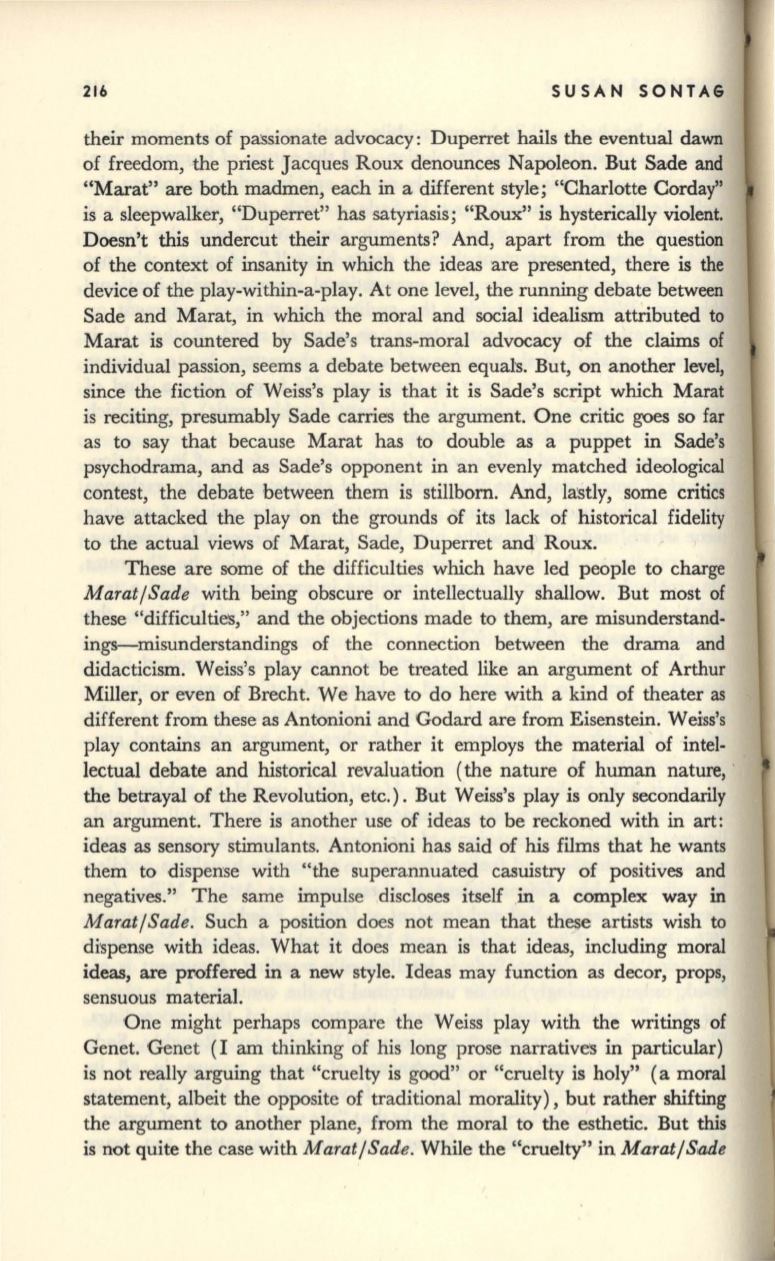
216
SUSAN
SONTAG
their moments of passionate advocacy: Duperret hails the eventual
dawn
of freedom, the priest Jacques Roux denounces Napoleon. But Sade and
"Marat" are both madmen, each in a different style; "Charlotte Corday"
is a sleepwalker, "Duperret" has satyriasis; "Roux" is hysterically violent.
Doesn't this undercut their arguments? And, apart from the question
of the context of insanity in which the ideas are presented, there is the
device of the play-within-a-play. At one level, the running debate between
Sade and Marat, in which the moral and social idealism attributed to
Marat is countered by Sade's trans-moral advocacy of the claims of
individual passion, seems a debate between equal's. But, on another level,
since the fiction of Weiss's play
is
that it is Sade's script which Marat
is reciting, presumably Sade carries the argument. One critic
goes
so far
as to say that because Marat has to double as a puppet in Sade's
psychodrama, and as Sade's opponent in an evenly matched ideological
contest, the debate between them is stillborn. And, la:stly, some critics
have attacked the play on the grounds of its lack of historical fidelity
to the actual views of Marat, Sade, Duperret and Roux.
These are some of the difficulties which have led people to charge
Marat/Sade
with being obscure or intellectually shallow. But most of
these "difficulties," and the objections made to them, are misunderstand·
ings-misunderstandings of the connection between the drama and
didacticism. Weiss's play cannot be treated like an argument of Arthur
Miller, or even of Brecht. We have to do here with a kind of theater as
different from these as Antonioni and Godard are from Eisenstein. Weiss's
play contains an argument, or rather it employs the material of intel·
lectual debate and historical revaluation (the nature of human nature, .
the betrayal of the Revolution, etc.). But Weiss's play is only secondarily
an argument. There
is
another use of ideas to be reckoned with in art:
ideas as sensory stimulants. Antonioni has said of
his
films that he wants
them to dispense with "the superannuated casuistry of positives and
negatives." The same impulse discloses itself in a complex way
in
Marat/Sade.
Such a position does not mean that these artists wish to
di'spense with ideas. What it does mean is that ideas, including moral
ideas, are proffered in a new style. Ideas may function as decor, props,
sensuous material.
One might perhaps compare the Weiss play with the writings of
Genet. Genet (I am thinking of his long prose narratives in particular)
is not really arguing that "cruelty is good" or "cruelty is holy" (a moral
statement, albeit the opposite of traditional morality), but rather shifting
the argument to another plane, from the moral to the esthetic. But
this
is not quite the case with
Marat/Sade.
While the "cruelty" in
Marat/Sade


